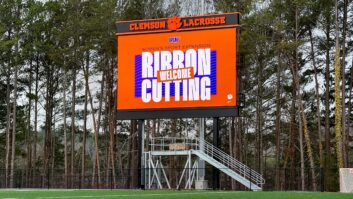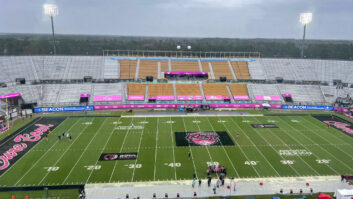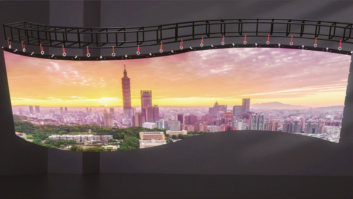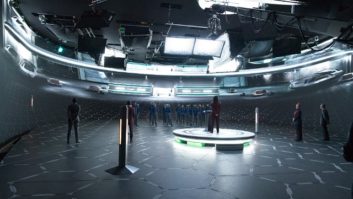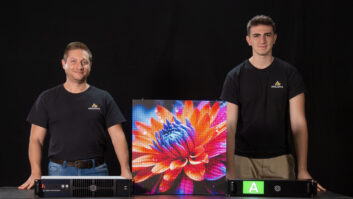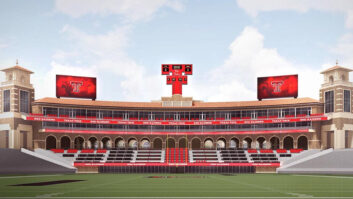
Installation catches up with Rob Fowler, senior business development manager at Brompton Technology, to talk about some of the latest advances in LED processing technology and where he thinks these advances can bring positive change in installed applications…
LED video technology is finding its way into ever more diverse applications, from broadcast, sports and digital signage to boardrooms, hotel atriums and even private homes. As consumers become more educated about what they can expect from top end displays are you seeing this translate into demands for higher spec processing?
Very much so. There has been an explosion in the growth of LED screens over the last decade in a variety of different applications. This is largely driven by the increasing affordability of such screens, following a significant shift in the manufacturing process to Asia. Initially, these screens were supplied with basic stock processing only, but that began to change some years ago in rental and staging and we are seeing that trend now replicated in other markets. Customers are specifying more fully featured processing systems from the panel suppliers at the point of order, instead of the basic ‘sending cards’ that such screens were often supplied with in the past. The benefits of better processing, coupled with better availability as manufacturers like Brompton open offices near the panel manufacturers in China, has made this process more accessible, too.
What sort of features are customers being attracted to in these more fully featured processors
For a start, there is speed and ease of use coupled with local support. That has been a major consideration in time-critical rental applications, but less so until now in installed applications where the extra spend for this purpose wasn’t always considered necessary. As the cost of more fully featured processing comes down though I think everyone appreciates a product with a cleaner and more user-friendly interface, which can be supported more easily. More substantively, customers are beginning to see the cost benefit of things like better colour correction systems. Often, when a tile has to be replaced in an existing installation, the newer tile will not match, and seams may show where mechanical alignment differs slightly. Basic processing systems might allow corrections for red, green and blue, but in all likelihood this will only mean that one primary colour or white can be correct at any one time. More sophisticated colour correction systems now allow correction for white, each of the primaries, and even secondary colours on site and without the need for extra equipment. That translates to a near perfect colour match, thus extending the life of a screen which might otherwise have looked patchy.
You may also be interested in:
- Seismic changes: Charting the transition from LCD to LED
- The move to LED: Who’s leading the way and who’s playing catch-up?
- ‘There is significant business to be won’: What Samsung DID’s LCD exit means for the biz
Are new developments like HDR coming to the fore on LED screens in your experience?
Yes, absolutely. More and more customers who are used to seeing HDR in domestic environments are demanding it in their commercial applications, too, as more content becomes available and creating content in HDR becomes simpler and more widely understood. Almost all the main LED processing manufacturers have released some sort of HDR compatibility, often choosing to support one or other of the main commercially available HDR standards. At Brompton, we have chosen to support HLG (Hybrid Log Gamma) and HDR10. HLG is comparatively easy to work with and doesn’t have any metadata that can present problems for some video workflows. HDR10 (also known as PQ or Perceptual Quantization) has that metadata and offers even more stunning results.
LED panels offer some significant advantages for displaying HDR content. For a start, most LED screens are bright and can take advantage of the extra brightness information in an HDR signal, and many LED packages can reach beyond the REC 709 colour gamut of traditional SDR displays and at least some way into the REC2020 colour space favoured for HDR.
There is an important caveat though. Both brightness and saturation of LED screens are hampered by traditional forms of factory calibration. That’s the process whereby panels are measured at the factory and all LED packages set to a value they can achieve so as to create uniformity. This is usually done by balancing to something close to the lowest common denominator, thus depriving the screen of its peak brightness and saturation.
At Brompton we realised when we began working on HDR that a totally new way of doing this calibration was required. So we developed it and we call that process Dynamic Calibration. Using Dynamic Calibration it’s possible to release the maximum amount of performance from every pixel in the display and the results can be quite stunning.
Seeing the response of industry veterans, newcomers and end-users alike to some beautifully shot footage displayed at LDI and ISE this year on four and half year old screens, which had been dynamically calibrated, convinced me that this is the future.
What other technical requirements do you think will be increasingly sought after over the next 12-18 months?
High input frame rate is something we are seeing an increasing demand for. Typically, that’s people asking for anything over standard 50 and 60Hz refresh rates and can be as high as 144Hz. This is driven partly by the rise in E-Sports and e-gaming, where the smooth reproduction of graphics is a priority. Some of the purpose-built e-Sports arenas being developed right now are huge and present a massive opportunity for our sector.
The other big frontier is latency or delay. This is particularly applicable for things like Extended Reality (XR) applications, such as virtual film and TV studios, which are becoming popular for sports broadcasts, as well as for sophisticated theme park and visitor experiences.
Increasing frame rates means a 33 milli-seconds delay that would have occurred with two frames of delay at 60Hz is now halved. If your processor can get down to one frame at 120 Hz that can mean a reduction to just eight mS delay which, for things like XR setups with camera tracking and feedback, is really key.
We are seeing this making a huge impact in the film and television world already. For example, recent productions like Disney-Lucasfilm’s The Mandalorian was shot almost entirely in front of LED screens rather than on location, with stunning results.

